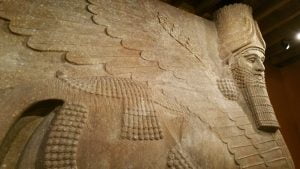
Welcome to part of Sargon’s throne room – the complete room was as big as a football field. Look to the left for a diagram and in the center for sample flooring.
Archaeologists were often allowed to keep half of what they uncovered. Recently, ISIS destroyed four similar giant lamassu in Ninevah.
Isaiah 20:1 – “In the year that Tartan came unto Ashdod, (when Sargon the king of Assyria sent him,) and fought against Ashdod, and took it …”
Sargon??? Was the biblical writer mistaken???
“For many years, skeptics insisted that the biblical writer must be mistaken. After all, many inscriptions and archaeological finds from the Assyrian Empire had been found, yet not a single one of them mentioned the Sargon of Isaiah 20. In fact, a well-known list of Assyrian kings conspicuously omitted Sargon (Wilson, 1999, 3:78). But in 1843, Paul Emile Botta dealt the deathblow to this argument. Acting on information he had received about the small village of Khorsabad, Iraq, Botta began searching for ancient bricks with cuneiform writing on them. Not only did he find a rich cache of such bricks, but he also stumbled upon one of the most magnificent finds in archaeological history. Occupying the entire side of a hill, buried under centuries of dirt, stood the remains of King Sargon’s palace. This palace was of such size that it has been described as “probably the most significant palace the world has ever seen, covering an area of more than twenty-five acres.” Among the ruins, Sargon left numerous inscriptions detailing his military conquests. Not the least among those inscriptions was a particularly revealing inscription discussing his actions against Ashdod, the very city mentioned in Isaiah 20:1.” (Kyle Butt, M.Div., as published in Apologetics Press)
http://www.apologeticspress.org/APContent.aspx?category=13&article=852